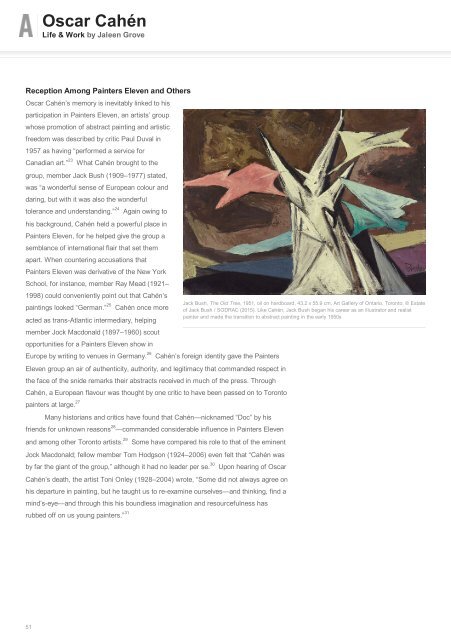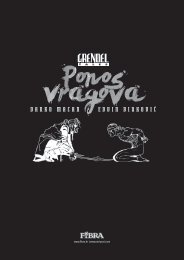Oscar Cahén
Art-Canada-Institute_Oscar-Cah%C3%A9n
Art-Canada-Institute_Oscar-Cah%C3%A9n
Create successful ePaper yourself
Turn your PDF publications into a flip-book with our unique Google optimized e-Paper software.
<strong>Oscar</strong> <strong>Cahén</strong><br />
Life & Work by Jaleen Grove<br />
Reception Among Painters Eleven and Others<br />
<strong>Oscar</strong> <strong>Cahén</strong>’s memory is inevitably linked to his<br />
participation in Painters Eleven, an artists’ group<br />
whose promotion of abstract painting and artistic<br />
freedom was described by critic Paul Duval in<br />
1957 as having “performed a service for<br />
23<br />
Canadian art.” What <strong>Cahén</strong> brought to the<br />
group, member Jack Bush (1909–1977) stated,<br />
was “a wonderful sense of European colour and<br />
daring, but with it was also the wonderful<br />
tolerance and understanding.” Again owing to<br />
his background, <strong>Cahén</strong> held a powerful place in<br />
Painters Eleven, for he helped give the group a<br />
semblance of international flair that set them<br />
apart. When countering accusations that<br />
Painters Eleven was derivative of the New York<br />
School, for instance, member Ray Mead (1921–<br />
1998) could conveniently point out that <strong>Cahén</strong>’s<br />
paintings looked “German.” <strong>Cahén</strong> once more<br />
acted as trans-Atlantic intermediary, helping<br />
member Jock Macdonald (1897–1960) scout<br />
opportunities for a Painters Eleven show in<br />
Europe by writing to venues in Germany. <strong>Cahén</strong>’s foreign identity gave the Painters<br />
Eleven group an air of authenticity, authority, and legitimacy that commanded respect in<br />
the face of the snide remarks their abstracts received in much of the press. Through<br />
<strong>Cahén</strong>, a European flavour was thought by one critic to have been passed on to Toronto<br />
painters at large.<br />
Many historians and critics have found that <strong>Cahén</strong>—nicknamed “Doc” by his<br />
friends for unknown reasons —commanded considerable influence in Painters Eleven<br />
and among other Toronto artists. Some have compared his role to that of the eminent<br />
Jock Macdonald; fellow member Tom Hodgson (1924–2006) even felt that “<strong>Cahén</strong> was<br />
by far the giant of the group,” although it had no leader per se. Upon hearing of <strong>Oscar</strong><br />
<strong>Cahén</strong>’s death, the artist Toni Onley (1928–2004) wrote, “Some did not always agree on<br />
his departure in painting, but he taught us to re-examine ourselves—and thinking, find a<br />
mind’s-eye—and through this his boundless imagination and resourcefulness has<br />
rubbed off on us young painters.”<br />
27<br />
25<br />
28<br />
24<br />
29<br />
31<br />
26<br />
Jack Bush, The Old Tree, 1951, oil on hardboard, 43.2 x 55.9 cm, Art Gallery of Ontario, Toronto, © Estate<br />
of Jack Bush / SODRAC (2015). Like <strong>Cahén</strong>, Jack Bush began his career as an illustrator and realist<br />
painter and made the transition to abstract painting in the early 1950s<br />
30<br />
51



